The Phallus in Stone Age Art
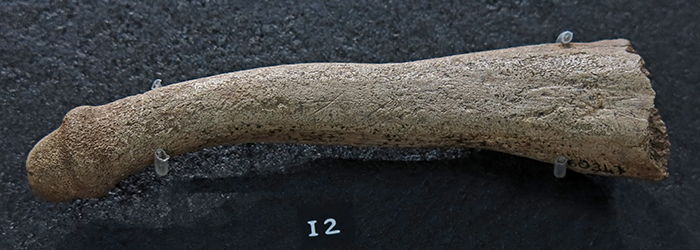
Phallus carved from reindeer antler - Upper Magdalenian, from la Madeleine.
Photo: Don Hitchcock 2014
Source: Original, Le Musée National de Préhistoire, Les Eyzies-de-Tayac

Phallus carved from reindeer antler - Upper Magdalenian, from la Madeleine.
Photo: Don Hitchcock 2008
Source: Original, Le Musée National de Préhistoire, Les Eyzies-de-Tayac
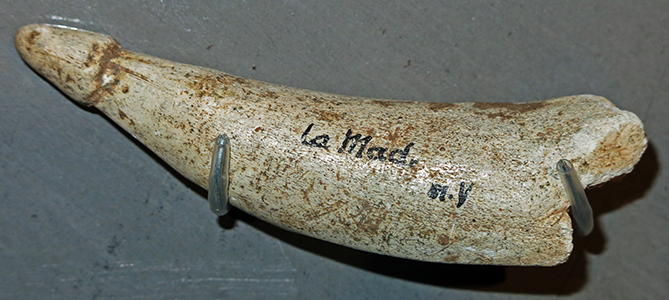
Phallus, as above, fortuitously showing the other side.
Carved in the round of reindeer antler, on loan from Les Eyzies-de-Tayac, musée national de Préhistoire.
la Madeleine
Label:
Bois de renne sculpté en ronde bosse, La Madeleine, Fouilles Capitan et Peyrony
Les Eyzies-de-Tayac, musée national de Préhistoire, MNP 1928-7-15
Photo: Don Hitchcock 2014
Source: Musée d’art et d’archéologie du Périgord, Périgueux

Phallus from Fournau du Diable.
Made of deer antler, this is a relatively small phallus compared with some others, though the one from la Madeleine, above, is of similar size.
Photo: Don Hitchcock 2014
Source: Original, Le Musée National de Préhistoire, Les Eyzies-de-Tayac

Phallus from Roc-de-Marcamps, Prignac-et-Marcamps, Magdelanian.
Reindeer antler, length 180 mm, width 29 mm.
Photo: Don Hitchcock 2015
Catalog: 75.16.2
Source: Original, Musée d'Aquitaine à Bordeaux

The phallus is in the form of a spear straightener, or bâton percé.
Photo: Don Hitchcock 2015
Catalog: 75.16.2
Source: Original, Musée d'Aquitaine à Bordeaux

Phalliform sculptures from Roc de Marcamps.
The photograph on the left is of the phallus shown in the images immediately above.
Photo: Allain et al. (1985).
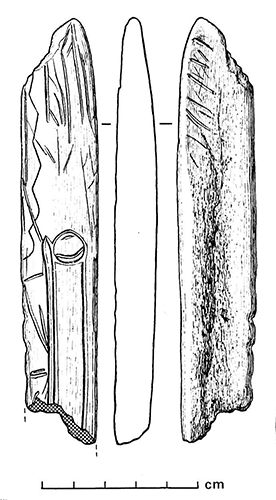

Engraving of a phallus on an antler from a reindeer, from La Grotte de Fontarnaud, commune de Lugasson (Gironde),
The object itself is shaped like a large, thick lissoir or smoother of hides.
The engraving includes the foreskin, the glans, and the meatus, or the slit through which passes urine and semen.
Catalog: 82.15.77
Photo (left) and text: Roussot et Ferrier (1971)
Photo (right): Don Hitchcock 2015
Source: Original, Musée d'Aquitaine à Bordeaux

Broken bone rod from La Madeleine engraved with the head of a bear facing a complex phallic form. Upper Magdalenian.
Photo and text: Marshack (1972)

This baguette demi-ronde is possibly one half of a projectile point that together with another similar one would form a specific point - a baguette demi-ronde. - Middle Magdalenian.
(The carvings on this piece are surreal - it includes what looks like a bear's head and a double phallus - Don )
Photo: Don Hitchcock 2008
Source: Original on display at Le Musée National de Préhistoire, Les Eyzies-de-Tayac

Phallus from Mas d'Azil.
Phallus
Carved ivory
Cat 359
Origin : Mas-d’Azil cave, Ariège
Photo: © photo - Loïc Hamon, Musée des Antiquités nationales, Saint-Germain-en-Laye.
Photo Source: http://www.culture.gouv.fr/culture/app/eng/96ce1735.htm

This piece is a kind of thick blade with rounded tip and slightly curved. The opposite end, which expands and thickens, is broken, it has been pierced by a hole, but only a small portion of it is visible.
On one side stands a figure in relief, in which it is difficult to see anything other than a penis, and probably a human penis, although somewhat thin. The glans, drawn like the rest of the figure by a burin, is slightly raised. It has an oval, elongated form. A broad-furrow dug at the top clearly marks the urethra. The actual body of the penis tapers gradually to the transverse line that separates the glans from the shaft of the penis. As it is now, the piece measures 14 cm long.
Photo and text: Mortillet (1906)
Ancient phallus unearthed in cave
By Jonathan Amos
BBC News science reporter
http://news.bbc.co.uk/1/hi/sci/tech/4713323.stm
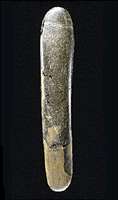
A sculpted and polished phallus found in a German cave is among the earliest representations of male sexuality ever uncovered, researchers say. The 20cm-long, 3cm-wide stone object, which is dated to be about 28,000 years old, was buried in the famous Hohle Fels Cave near Ulm in the Swabian Jura. The prehistoric 'tool' was reassembled from 14 fragments of siltstone. Its life size suggests it may well have been used as a sex aid by its Ice Age makers, scientists report.
'In addition to being a symbolic representation of male genitalia, it was also at times used for knapping flints, explained Professor Nicholas Conard, from the department of Early Prehistory and Quaternary Ecology, at Tübingen University. 'There are some areas where it has some very typical scars from that,' he told the BBC News website. Researchers believe the object's distinctive form and etched rings around one end mean there can be little doubt as to its symbolic nature.
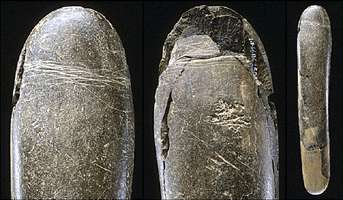
'It's highly polished; it's clearly recognisable,' said Professor Conard.
The Tübingen team working at Hohle Fels already had 13 fractured parts of the phallus in storage, but it was only with the discovery of a 14th fragment last year that the team was able finally to put the 'jigsaw' together. The different stone sections were all recovered from a well-dated ash layer in the cave complex associated with the activities of modern humans (not their pre-historic 'cousins', the Neanderthals). The dig site is one of the most remarkable in central Europe. Hohle Fels stands more than 500m above sea level in the Ach River Valley and has produced thousands of Upper Palaeolithic items.
Large phallus at le Sanctuaire des Trois-Frères
The composition and complexity of the fantastic bestiary of the Sanctuary has not yet ceased to surprise us and pose new questions. In fact it took a new examination to notice a large engraved phallus in the middle of the first panel, situated just above a natural concavity in the wall which evokes the shape of a vulva (Fig. 1). We immediately asked ourselves how neither the Bégouën family nor other visitors over the course of almost a century, nor Breuil in his 18 years of work in the cave, noticed this figure which is nevertheless clearly visible upon arrival in the Sanctuary. To suspect them of prudery or even censorship does not seem credible. However, the precise position of the phallus, situated on an edge of the wall forming a near right angle, and separating two panels studied until then one after the other, might perhaps be a reason.Reading the right-hand panel is fairly difficult and less attractive than that of the preceding one with its mammoth, humans and arrow-marked bison. Perhaps the exceptional size of this engraving plays a part? It is much bigger than the surrounding drawings and necessitates standing back to understand it. The extremely delicate Magdalenian art of Les Trois-Frères cave has survived its first ‘public' century intact. To mark this centenary the publication of a study “Les Trois-Frères cave, an anthology and new finds” will provide an updated overview. Localisation and description of the phallus Breuil described the engraved panels of the Sanctuary from right to left (Bégouën et Breuil, 1958). The phallus is situated in the middle of the first part of the right-hand wall, at 1.2 m from the floor, at the intersection of the 3rd, 4th and 5th panels.
The whole of the engraving measures 59 cm long from the glans to the pubic triangle and from 7 to 11 cm wide.
Text above: Bégouën et Bégouën (2013b)
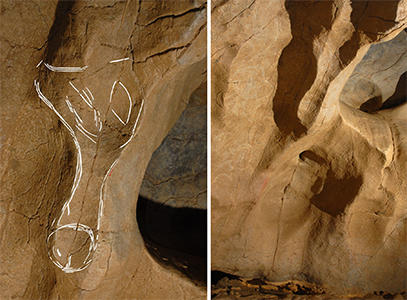
Le Sanctuaire des Trois-Frères
Drawing of a phallus, and an overview of the phallus and vulva, with a presentation of the reliefs which inspired the figures. Photo and drawings É. Bégouën.
Among the phallic representations recorded, the morphology seems realistic, although sometimes the dimensions are exaggerated, with the Bédeilhac phallus of 28 cm, or at Fronsac, where there is a phallus of 38 cm, but only at les Trois Frères do we find such an oversized representation. It is 59 cm in length, which may be compared to the other largest figure, a mammoth, which is only 53 cm. This disparity makes us wonder if the size is purely because of the space for it on the wall, or if the size is significant for other reasons.
Photo and text: Bégouën et Bégouën (2013a)
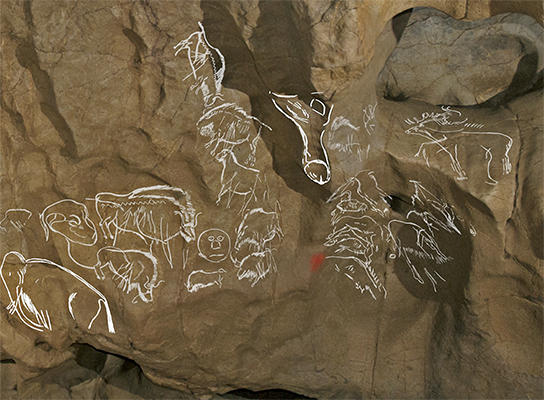
General view of the graphics context of the phallus panels 3, 4, 5 of le Sanctuaire des Trois-Frères.
Drawings by Breuil, photography and montage by É. Bégouën
Unlike other decorated caves of the Magdalenian, female representations are almost absent at les Trois Frères, except for what may be a vulva, while male representations are clearly present , including the Man-Bison, the small sorcerer with the nose flute, and of course the Sorcerer. This dominance emphasises the originality of the grotte des Trois-Frères. (Bégouën, 1929)
Photo and text: Bégouën et Bégouën (2013a)
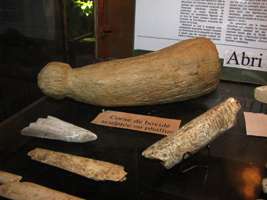
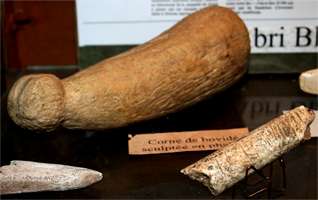
This is a very interesting phallus carved from a bison horn from Abri Blanchard. The carving is about 36 000 years old and is 250 millimeters long. It must be one of the largest such phallus shapes ever found. The carving shows clearly the cleft at the end of the phallus, seen especially in the photo on the right.
Note also the carved bone in the foreground.
Photo: (left) Don Hitchcock 2008
Photo: (right) Carolyn Hailstones 2009
Source: Facsimile, Musée de la préhistoire à Sergeac
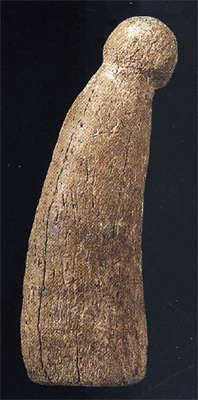
Another version of the phallus above, length 250 mm
Photo: Roger Joussaume, CNRS
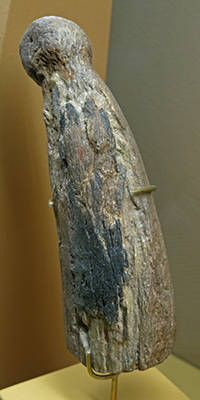
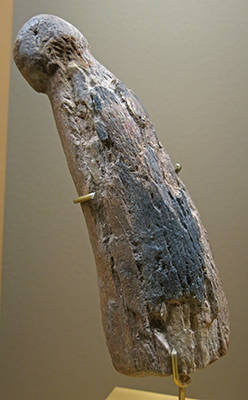
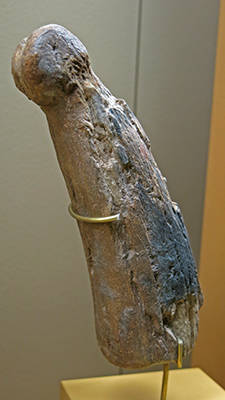
Aurignacian of l'abri Blanchard des Roches à Sergeac, Dordogne
28: Sculpture figurant un phallus, corne, sculpture of a phallus, horn.
Photo: Don Hitchcock 2014
Source: Original, Musée d'Archeologie Nationale et Domaine, St-Germain-en-Laye
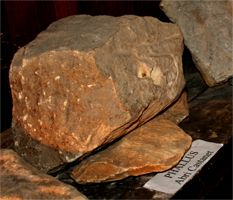

Phallus carved in stone from Abri Castanet, showing testicles as well. I have outlined the carving in the version on the right.
The flat stone in front is there just to prop up the carved stone, as far as I can tell.
Photo: Carolyn Hailstones 2009
Source: original, Musée de la préhistoire à Sergeac
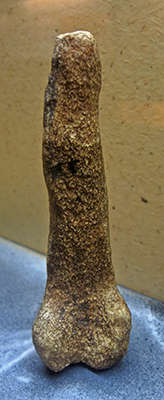
This phallus from Isturitz has very little documentation, and is mentioned only briefly in scholarly works.
Photo: Don Hitchcock 2014
Source: Display, Grottes d'Isturitz et Oxocelhaya
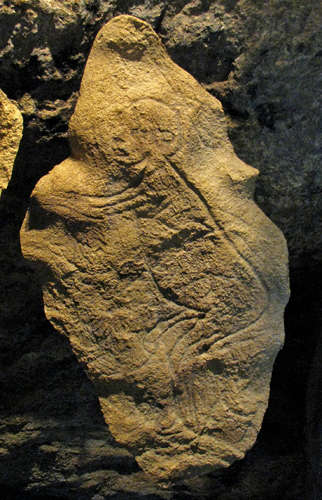
Facsimile of the Sorcerer, from the display at Grotte du Sorcier, which shows an enlarged and erect phallus.
Photo: Don Hitchcock 2008
Source: Facsimile, display at Grotte du Sorcier
Almost certainly a cast from the mold of 1966 made by Abbé Glory
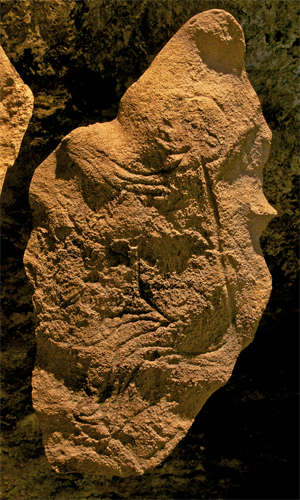
Facsimile of the Sorcerer, from the display at Grotte du Sorcier
Photo: Jebulon
Permission: Creative Commons CC0 1.0 Universal Public Domain Dedication.
Source: Facsimile, display at Grotte du Sorcier
Almost certainly a cast from the mold of 1966 made by Abbé Glory
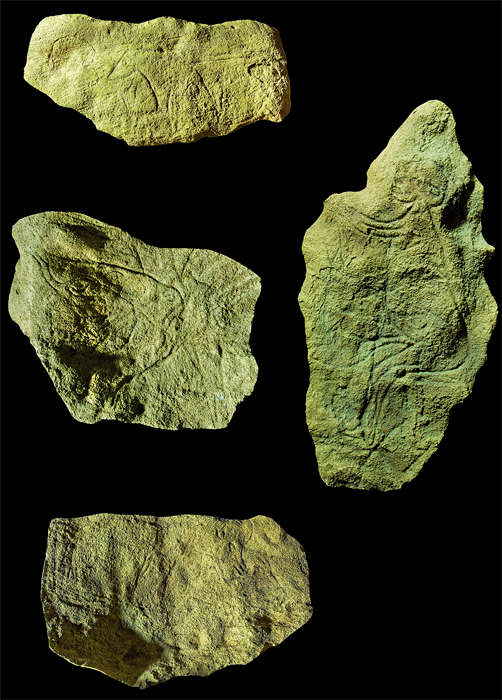
Casts of representations 25 to 27 (top left), of Bison 15 (middle left), of representations 23 and 24 (bottom left), of the 'Sorcerer' 18 (on the right in the middle), made by R. David from Glory’s 1966 casts.
Photo: H. Paitier 2009
Source and text: Pigeaud et al (2012)
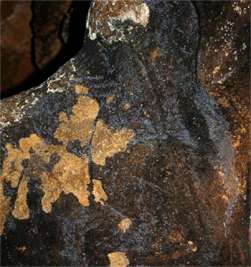
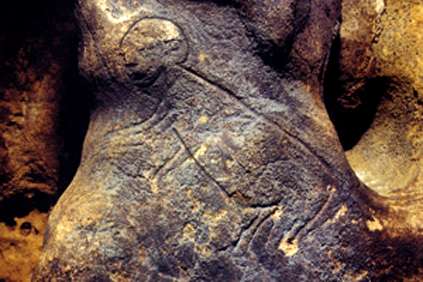
This is image No. 37 (according to Dams (1980)), or No. 18 (according to Delluc et al (1987)), known as the Sorcerer.
(Note: If one compares even modern colour photographs as shown here, the deterioration in recent times is very obvious. When flakes of rock fall away, they remove the grey patina and expose the yellowish rock beneath. In addition, the white fungal growth around the head seems to be increasing in area and thickness. The oldest photograph is the one to the lower left in this group - Don)
Photo: (far left) http://www.grottedusorcier.com/main.html, Source: Original, Grotte du Sorcier
Photo: (left) http://www.perigorddecouverte.com/perigord_pages.php?menu=3&rubrique=11&id_pays= , Source: Original, Grotte du Sorcier
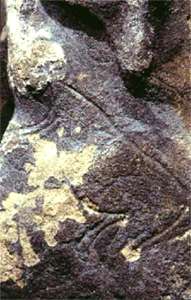
Another image
Representation of a human with an erect phallus, located on the roof in the deepest part of the cave. The man has a narrow thorax, distended abdomen, extended upper limbs, and the head is round. The engraving is on limestone, the surface of the rock is affected by falling flakes primarily in the ventral part. The cave was closed for twenty years. This helped to stop the proliferation of microorganisms associated with various parameters, including light and heat. The superficial flaking of the limestone seems to have been naturally stabilised for twenty years and is one of the positive effects of the management of the cave.
Photo, and text translated from the French at: http://www.culture.gouv.fr/culture/conservation/fr/grottes/Pageshtm/cirq1.htm
My adaption and translation of Delluc et al (1987) with respect to this figure follows:
Man in profile
The figure is about 50 cm high and 22 cm wide, and is turned to the left. It is carved towards the top of the vault, on a support almost at the top, inclined at an angle of 10° to the horizontal. The surface texture has been used to give relief to the figure: the line of the head has been sited on a small rounded boss. The chest is drawn on a concave area, the arms on a surface slightly convex, as also the stomach and legs. The axis of the figure is at an oblique angle to the axis of the joints, the head being directed to the floor of the cave and the feet away from the axis of the joints.
The surface is very dark and grainy, affected by the falling of flakes from the surface, exposing the yellowish rock. Some flakes appear to have fallen before or contemporaneous with the discovery, if one refers to old photos. Others have appeared between that date and 1959, at which date the photographs of J. Vertut and A. Leroi-Gourhan were prepared for la Préhistoire de l'art occidental and may be related to the first cast of the engraving from which very accurate information was obtained.
Bluish traces mark the location (including scars of flakes) of a cast carried out on the 12th and 13th April, 1966 under the direction of Abbé Glory and kept in l'institut de Paleontologie humaine in Paris, but no one seems to have imputed the damage done to him.
Finally, the location of the head is the seat of the development of white blooms of fungus that appear to have proliferated recently, which we particularly noticed during a visit with M. Lorblanchet on 23/12/1986.
The figure is carved throughout with fairly broad strokes, 2 to 10 mm wide, and 1 to 5 mm deep.

Tracing by Abbé Glory at the time of discovery, 4th May 1953, of the Sorcier, and a clean version of the tracing, also by Abbé Glory.
Photo: Delluc et al (1987)
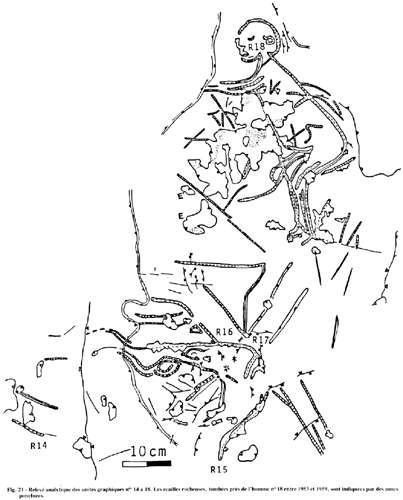
Drawing of the section surrounding the Sorcier. The flakes of rock which fell from the area between 1953 and 1959 are indicated by the dotted areas.
Photo: Delluc et al (1987)
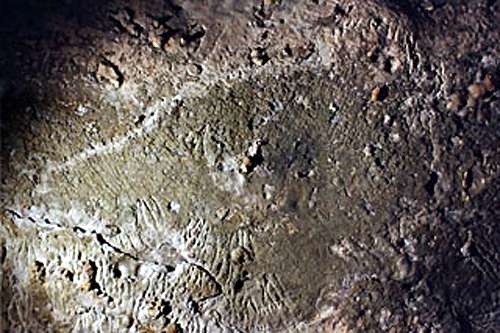
Bison.
The engraving consists of a right profile, with just the dorsal line leading to the head on the right of the image.
Above the bison is what appears to be a phallus.
The crack along the lower part of the image and the cave bear claw marks are not a part of the engraving of the bison.
Photo: Gilles Delluc
Source: http://www.hominides.com/html/lieux/grotte-bara-bahau.php
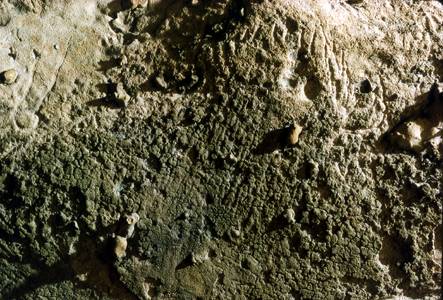
Bison and a phallus.
Photo: © Lestrade
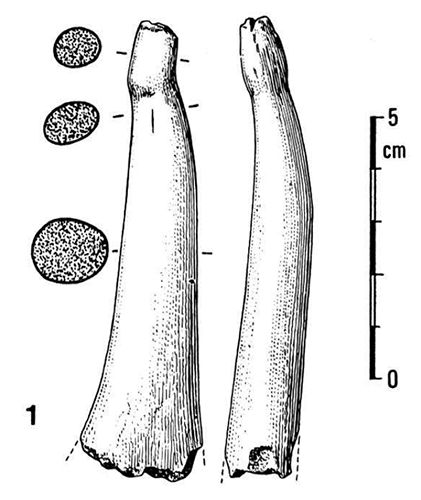

l'Abri du Morin, Layer A IV
End of reindeer antler. Length 88 mm. The distal portion has been scraped to the shape of a phallus, with normal peripheral narrowing and an incision of the penis at the glans shown, which has since deteriorated to some extent.
The shaping of the phallus was relatively easy because of the natural shape of the antler. The object is similar to other carved antlers, in the sense that it is simple and undecorated, as for, notably, number 7 of layer A II from the same site, and the phallus from la Madeleine, or the very ornamented one from Bruniquel and that from Abzac, which is a double version.
When discussing a wooden phallus from the Aurignacian, coming from l'abri Blanchard des Roches, much earlier than the examples cited above, which are all from the upper Magdalenian, L. Didon proposed the existence of a very ancient cult of the male genital organ.
R. Montandon thought that the objects were intended to 'satisfy perverted desires' (that is, that they were dildos - Don ).
Photo (left) and text: Deffarge et al. (1975)
Photo (right): Don Hitchcock 2015
Source: Original, Musée d'Aquitaine à Bordeaux
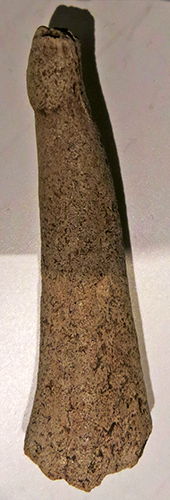
l'Abri du Morin Layer A IV
To link these phalluses to magic or to a fertility cult, it must be assumed that the relationship between the sexual act and conception was understood by people of the Upper Paleolithic.
Regardless of their meaning and their use, these very realistic phalluses show that a psychological restriction against showing sex organs was not absolute.
They may be further evidence of the innate tendency of humans to transform, by simple work, a suggestive natural form.
Text: Deffarge et al. (1975)
Photo: Don Hitchcock 2015
Source: Original, Musée d'Aquitaine à Bordeaux

The end of a deer antler, shaped into a phallus. Length 78 mm.
The distal portion is created by scraping to create a phallus-shaped peripheral bulge.
(this phallus from Layer A II is almost identical to the one above from Layer A IV above - Don )
Photo and text: Deffarge et al. (1975)
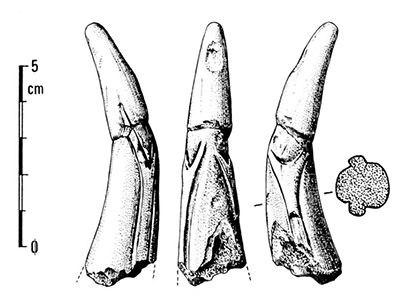
Cervid. End of reindeer antler, in two pieces. Length 73 mm. It is perhaps phalliform.
On the two opposite faces, two figurations in champlevé (the outline is surrounded by a deeply cut channel ) of the end of a deer antler, with the rod and a 'palm patch' (just below where the antler divides, as in fingers on the end of a hand - Don ).
Photo and text: Deffarge et al. (1975)
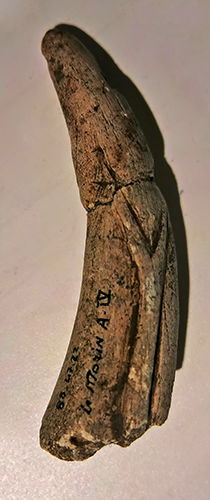
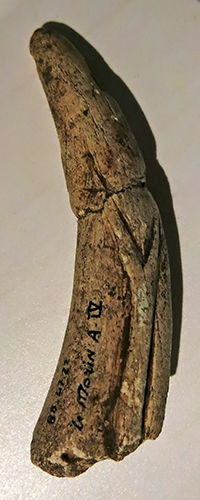
On one face (shown here), the two points are of unequal size, the longest, called the dagger, thus being differentiated. On the other, the points are of equal length. A deer antler from Gourdan, sharpened, is decorated like this with two deer antlers in champlevé style.
Text: Deffarge et al. (1975)
Photo: Don Hitchcock 2015
Source: Original, Musée d'Aquitaine à Bordeaux
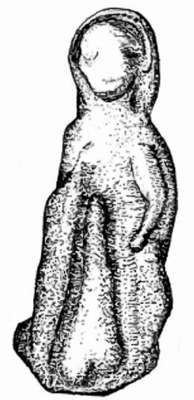
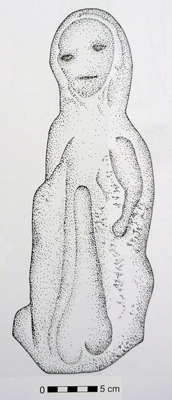
This is known as the Laussel priapus, found in a Gravettian layer aged 22 000 BP.
In Greek mythology, Priapus was a minor rustic fertility god, protector of livestock, fruit plants, gardens and male genitalia. Priapus is marked by his absurdly oversized, permanent erection, which gave rise to the medical term priapism. He became a popular figure in Roman erotic art and Latin literature, and is the subject of the often humorously obscene collection of verse called the Priapeia.
In archaeology, priapus is a term commonly given to a figure which is phallus like, or has a large phallus.
(left) Photo: http://www.actasurologicas.info/v30/n03/ESP/3003OR02.htm
Source: J.P. Duhard tracing
(right) Photo: Rau et al. (2009)
Text: adapted from Wikipedia.
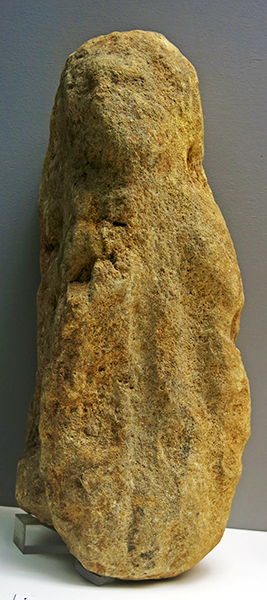
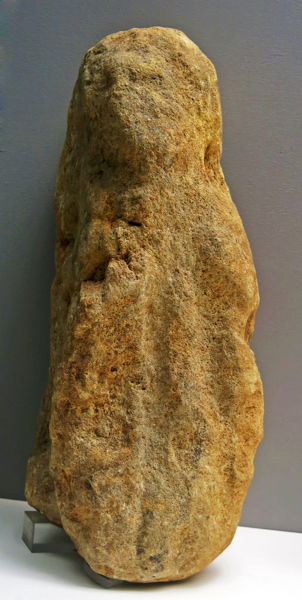
The Laussel priapus.
Material: Limestone
Age: Gravettian
Photo: Don Hitchcock 2015
Source: Original, Musée d'Aquitaine à Bordeaux
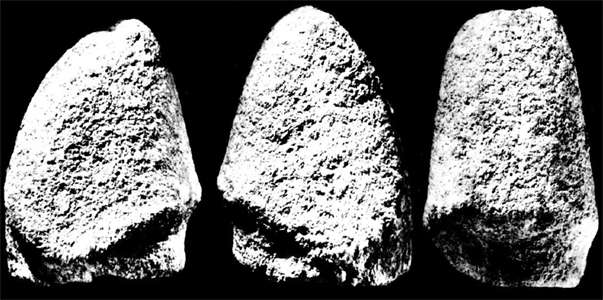
Glans penis, Laussel, kept in the Musée d'Aquitaine.
This has been carved from a fairly coarse sandy limestone. The object is broken at the former
level of the preputial sulcus, the fold between the glans and the foreskin.
The total length of the fragment is 64 mm, that of the glans itself 50 mm, with a maximum width of 43 mm. The diameter of the penis, substantially oval, varies from 46 to 39 mm. This piece comes from the upper Aurignacian level (i.e. Upper Perigordian), although the workers placed it in a box of the Aurignacian (i.e. Périgordien). The Laussel excavations were carried out by a team of workers under the direction of R. Peyrille, who regularly shipped material to Bordeaux by train.
No serious scientific surveillance was exercised, and the stratigraphic position of many finds remains unclear. However, the assignment of the object to the Upper Perigordian is very probable.
Photo and text: Duhard et Roussot (1988)
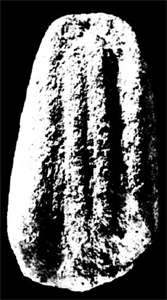
Representation of a glans penis and vulva, Laussel.
Photo: Duhard et Roussot (1988)
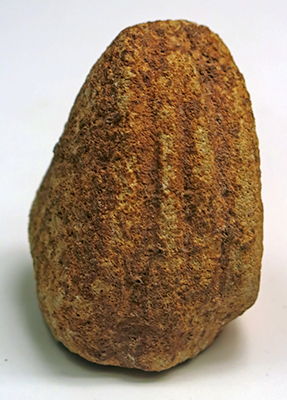
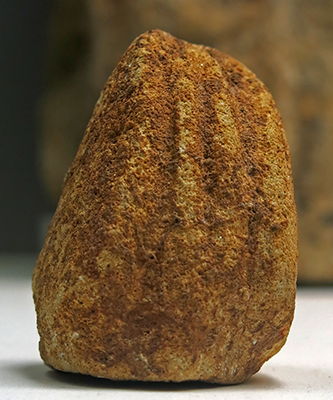
Representation of a glans penis and vulva, Laussel.
Material: Limestone
Age: Gravettian
Photo: Don Hitchcock 2015
Source: Original, Musée d'Aquitaine à Bordeaux
References
- Allain, J. et al, 1985: Le Magdalénien à navettes , Gallia préhistoire, 1985 Volume 28 Issue 1 pp. 37-124
- Bégouën E., Bégouën M., 2013b:New discoveries in the Sanctuary of Les Trois-Frères cave (Ariège), Quartär , 60 (2013): 107-114
- Bégouën L., 1939: Pierres gravées et peintes de lépoque magdalénienne, Mélanges Bégouën, pp. 289-305
- Bégouën E., Bégouën M., 2013a: Découverte d'un grand phallus gravé magdalénien dans la grotte des Trois-Frères (Ariège), Bulletin de la Société Préhistorique Française , Tome 110, numéro 1, janvier-mars 2013, p. 127-129.
- Bégouën H., 1920: Un dessin relevé dans la caverne des Trois-frères, à Montesquieu-Avantès (Ariège), Comptes rendus des séances de l'Académie des Inscriptions et Belles-Lettres, 64e année, N. 4, 1920. pp. 303-310.
- Bégouën H., 1929: À propos de l'idée de fécondité dans l'iconographie préhistorique, Bulletin de la Société préhistorique française, 26, 3, pp 197-199.
- Bégouën H., Breuil H., 1958: Les cavernes du Volp , Paris, Ed. Arts et métiers graphiques, p. 10, 48, 77, 89.
- Bégouën R., 1984: Projet d'étude globale les cavernes du Volp, http://www.cavernesduvolp.com/Begouen_1984.pdf
- Bégouën R., Clottes J., 2008: Douze nouvelles plaquettes gravées d'Enlène, Espacio, Tiempo y Forma, Serie I, Nueva época. Prehistoria y Arqueología, t. 1, 2008. pp. 77-92
- Bégouën R., Clottes J., Feruglio V., Pastoors A., 2014: La caverne des Trois-Frères, Co-edition Louis Association Bégouën / Somogy Editions d'Art, 248 pp, 288 ill.
- Bégouën R., Fritz C., Tosello G., Clottes J., Faist F., Pastoors A., Lacombe S., Fosse P., 2007: Les Magdaléniens modelaient aussi l'argileLes Dossiers d'Archéologie, No. 324, November/December 2007
- Dams, L., 1980: L'art Parietal De La Grotte Du Roc Saint-cirq BAR International Series 79: 1980. ISBN: 0860540928 ISBN-13: 9780860540922
- Deffarge R., Laurent P., de Sonneville-Bordes D., 1975: Art mobilier du Magdalénien supérieur de l'Abri Morin à Pessac-sur-Dordogne (Gironde), Gallia préhistoire, Tome 18 fascicule 1, 1975. pp. 1-64.
- Delluc, B., Delluc G., Guichard F., 1987: La grotte ornée de Saint-Cirq (Dordogne) Bulletin de la Société préhistorique française, Année 1987, Volume 84, Numéro 10 p. 364 - 393
- Duhard J., Roussot A., 1988 Le gland pénien sculpté de Laussel (Dordogne), Bulletin de la Société préhistorique française 1988, tome 85, N. 2. pp. 41-44.
- Marshack, A., 1972: The Roots of Civilization: the Cognitive Beginning of Man’s First Art, Symbol and Notation New York, McGraw-Hill
- Mortillet A. de, 1906: La grotte du Placard et le niveau d'Aurignac, C.R. XXXVe sion A.F.A.S., Lyon, 1906 (1907), p. 630-642.
- Pigeaud, R., Berrouet F., Bougard E., Paitier H., Pommier V., Pascal B., 2012: The Sorcerer’s cave in Saint-Cirq-du-Bugue (Dordogne, France): new readings. Report of the 2010 and 2011 campaigns , Paléo 23 | 2012, 223-248.
- Rau, S., Naumann D., Barth M., Mühleis Y., Bleckmann C., 2009: Eiszeit: Kunst und Kultur, Thorbecke, 2009, 396p. ISBN: 978-3-7995-0833-9
- Roussot A., Ferrier J., 1971: La Grotte de Fontarnaud commune de Lugasson (Gironde), Bulletin de la Société préhistorique française, Études et travaux. 1971, tome 68, N. 2. pp. 505-520.
Back to Don's Maps
 Back to Archaeological Sites
Back to Archaeological Sites

 The Venus of Milandes is a phallic shaped venus figure from the Dordogne valley, apparently of Paleolithic age. It was found by a five year old boy in a field, and taken home as one of a number of curiosities found that day. It was shaped from a silicified iron bearing limestone pebble, already with a phallic - feminine shape, and further altered to accentuate this interpretation. The object has a maximum height of 77.3 mm to a maximum width at the hips of 39.0 mm. The object weighs about 90 grams.
The Venus of Milandes is a phallic shaped venus figure from the Dordogne valley, apparently of Paleolithic age. It was found by a five year old boy in a field, and taken home as one of a number of curiosities found that day. It was shaped from a silicified iron bearing limestone pebble, already with a phallic - feminine shape, and further altered to accentuate this interpretation. The object has a maximum height of 77.3 mm to a maximum width at the hips of 39.0 mm. The object weighs about 90 grams.